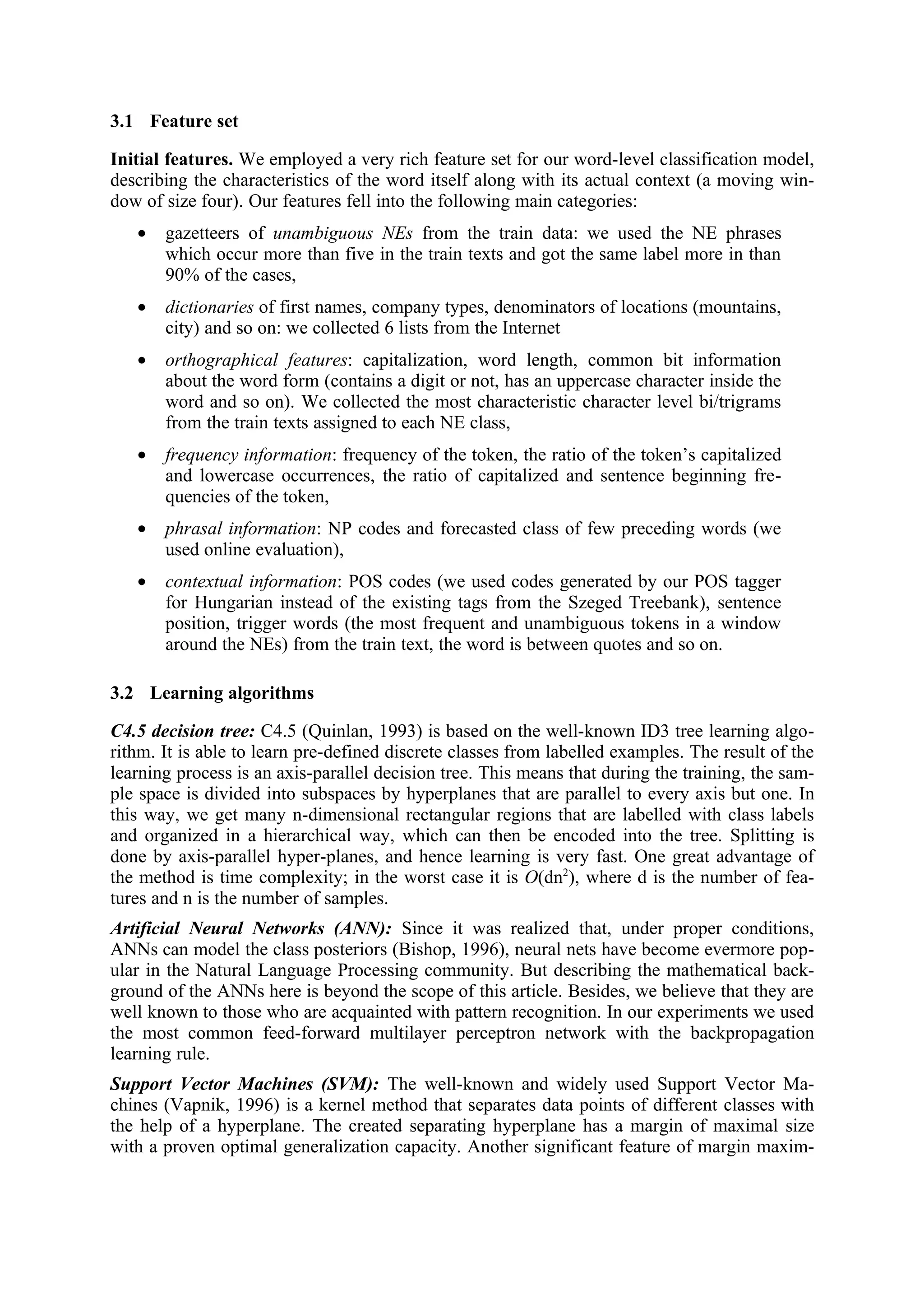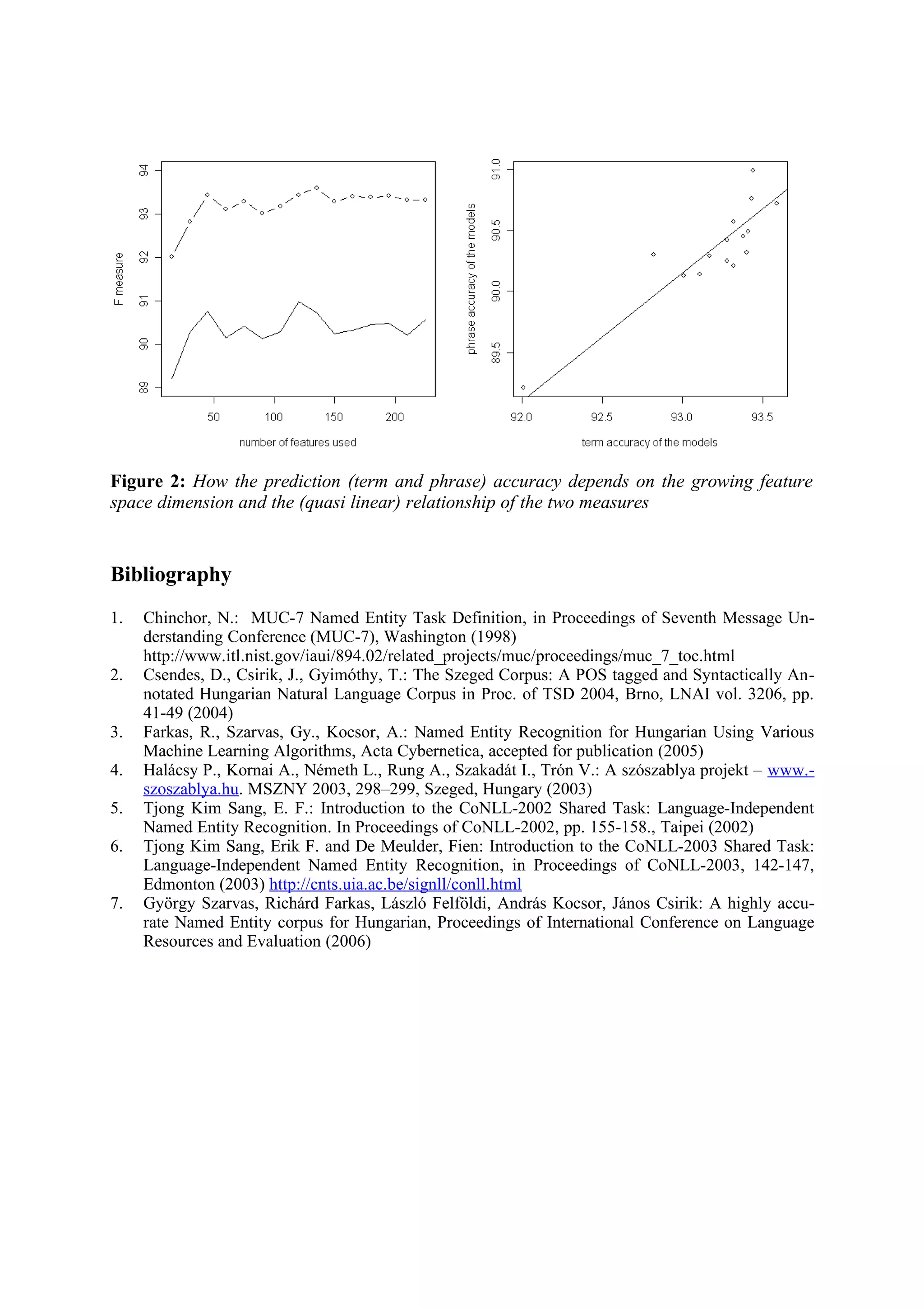This document describes statistical named entity recognition for Hungarian texts. The authors created a corpus of Hungarian news articles annotated with named entity tags. They used a rich set of 225 linguistic features to train support vector machines, neural networks, and decision trees. Their best model achieved an F-measure of 93.59% for term-level named entity recognition and 90.57% for phrase-level, outperforming prior rule-based systems for Hungarian. Feature selection helped reduce the feature set to 135 while maintaining high performance.
![Statistical Named Entity Recognition for Hungarian – analysis
of the impact of feature space characteristics
Richárd Farkas1, György Szarvas1
1 University of Szeged, Institute of Informatics
H-6720 Szeged, Aradi vértanuk tere 1.
{rfarkas, szarvas}@inf.u-szeged.hu
Abstract. In this paper we introduce a multilingual Named Entity Recognition (NER) system that
uses statistical modeling techniques. The system identifies and classifies NEs in Hungarian texts,
applying the Support Vector Classifier, Artificial Neural Network and C4.5 decision tree learning
algorithms. We focused on building as large a feature set as possible, and applied statistical pre-
processing methods for feature selection afterwards to fully exploit its potential. A segment of the
Szeged Treebank was used for training and validation purposes which consisted entirely of
newswire articles taken from the Hungarian News Agency (MTI). Our best system achieved a
93.59% F measure at term-level, and 90.57% at the more established phrase-level evaluation.
Keywords: Named Entity Recognition, NER,feature selection, machine learning
1 Introduction
The identification and classification of proper nouns in plain text is of key importance in nu-
merous natural language processing applications. In Information Extraction systems proper
names generally carry important information about the text itself, and thus are targets for ex-
traction. Machine Translation has to handle proper nouns and other sort of words in a differ-
ent way due to the specific translation rules that apply to them. These two topics are in the fo-
cus of our research.
1.1 Related work
The task of categorizing proper names was introduced during the 90s as a part of the shared
tasks in the Message Understanding Conferences [1]. The goal of these conferences was the
identification and classification of proper nouns (like person, organization, location name),
and phrases describing dates, time intervals, measures, quantities, and so on in texts collected
from newspaper articles in English.
As a part of the Computational Natural Language Learning conference in 2002 and 2003 [5,
6] a shared task dealt with the development of such systems that were able to identify the
more difficult classes defined in earlier approaches at MUCs simultaneously in two different
languages. These less obvious categories they focused on were person, organization and place
names, plus all proper nouns that did not belong to the three classes treated as miscellaneous
proper names.
Research and development efforts in the last few years have focused on other languages, do-
mains or cross-language recognition. Hungarian NER fits into this trend quite well, due to the
special agglutinative property of the language.
There are some results on NER for the Hungarian language as well but all of them are based
on expert rules [9], [12]. To our knowledge, no statistical models have yet been constructed
for the Hungarian language.](https://image.slidesharecdn.com/statistical-named-entity-recognition-for-hungarian-analysis4458/75/Statistical-Named-Entity-Recognition-for-Hungarian-analysis-1-2048.jpg)
![In this paper we will briefly describe and characterize our Named Entity Corpus of business
texts in Hungarian that was created at the University of Szeged, and introduce our current re-
search and experimental results on Hungarian NER in newswire articles.
2 The corpus
To train and test our NER model on Hungarian texts, we decided to use a sub-corpus of the
Szeged Treebank [2] which contains business news articles from 38 NewsML topics ranging
1 2
from acquisitions to stock market changes or the opening of new industrial plants. We anno-
tated this collection of texts with NE labels that followed the current international standards
as no other NE corpus of reasonable size is available for Hungarian. The data can be obtained
free of charge for research purposes . 3
One important characteristic of our data is the domain specificity of the corpus. The Hungari-
an texts we that we have consist of short newspaper articles from the domain of economy,
and thus the organization class dominates the other three in frequency. This difference un-
doubtedly makes NER an easier problem on the Hungarian text, while the special characteris-
tics of the Hungarian language (compared to English) like agglutinativity or free word order
usually makes NLP tasks in Hungarian very difficult. Thus it is hard to compare the results
for Hungarian with other languages but achieving similar results in English (the language for
which the best results have been reported so far) is still a remarkable thing.
The annotation procedure of the corpus consisted of several phases where two independent
annotators tagged the data and discussed problematic cases later on. In the final phase all the
entities that showed some kind of similarity to one that was judged inconsistent were collect-
ed together from the corpus for a review by the two annotators and the chief annotator. The
resulting corpus had an inter-annotator agreement rate of 99.89% and 99.77% compared to
the annotations made by the two linguists on their own [7].
This corpus, then, is completely equivalent to other corpuses used on the CoNLL-2002 and
CoNLL-2003 conferences, both in format and annotation style (the same classes are labeled).
We hope that this will make both cross-language comparison and the use of the corpus in de-
veloping NER systems more straightforward.
Table 1.: Corpus details
Tokens Phrases
Non-tagged tokens 200.067 ─
Person names 1.921 982
Organizations 20.433 10.533
Locations 1.501 1.294
Misc. entities 2.041 1.662
3 Our NER system for Hungarian
In this section we describe the major characteristics (features used, learning methods, feature
selection algorithms) of our system.
1 The project was carried out together with MorphoLogic Ltd. and the Hungarian Academy’s Research Institute for Lingu-
istics
2 See http://www.newsml.org/pages/docu_main.php for details.
3 http://www.inf.u-szeged.hu/~hlt/index.html](https://image.slidesharecdn.com/statistical-named-entity-recognition-for-hungarian-analysis4458/75/Statistical-Named-Entity-Recognition-for-Hungarian-analysis-2-2048.jpg)

![ization is that the calculated result is independent of the distribution of the sample points. Per-
haps the success and popularity of this method can be attributed to this property.
3.3 Feature selection
A general characteristic of learning models in Natural Language Processing is that the fea-
tures available are far from uncorrelated (and some might even be totally uninformative to the
target variable), thus the proper preprocessing of data can be beneficial both in terms of de-
creased training time and improved performance.
Chi-squared statistic: We used the well known chi-squared statistics to measure the associ-
ation between individual features and the target attribute (that is, the term’s NE label). This
statistical method computes how strong the dependency is by comparing the joint distribution
and the marginal distributions of the examined feature and the target variable. This way at-
tributes are ranked based on their individual relevance and this enables us to discard insigni-
ficant features automatically.
Figure 1: Outline of the structure of our NER model.
4 Experimental results
4.1 Metrics used
In this paper we will also evaluate our models using the phrase accuracy measures introduced
in the CONLL conferences along with term accuracy used in our previous experiments. In ev-
ery other aspect we followed the framework outlined in [3].
The values obtained from the two metrics for a certain prediction is illustrated in Figure 2b. It
can be easily seen that the relationship between them is quasi linear.](https://image.slidesharecdn.com/statistical-named-entity-recognition-for-hungarian-analysis4458/75/Statistical-Named-Entity-Recognition-for-Hungarian-analysis-4-2048.jpg)
![4.2 Feature space
Our recent research efforts have focused on enriching the embedding feature space with addi-
tional attributes of all kinds, ranging from orthographic parameters to values describing sen-
tence level information. We collected new features and finally had 225 different properties
for each token in the text we analyzed and then used them to construct supervised learning
models that could predict more effectively whether the token in question was part of an entity
name, and if so, we determined which of the four category it most likely belonged to.
The features that proved to be the most useful and informative (according to their Chi-square
score) for the given NER problem were frequency information collected from the Szószablya
[4] frequency dictionary, type of the first letter of the word (upper/lower case), whether the
word was a valid first name, whether it contained uppercase letters inside the word, case and
POS codes, the word length, position in the sentence, whether one of the consecutive words
was a company type (like ‘Plc.’, ’Ltd.’, ’Co.’, etc.), and whether the word was the name of a
country.
4.3 Results
No independent results on Hungarian NER using this corpus have yet been published. The re-
sults here are compared to our previous results, which we think are the best that have been
published so far [3].
Different machine learning methods (Artificial Neural Network, Support Vector Classifier,
Decision Tree Classifier) can achieve an F-measure of 90% or more regarding accuracy of
recognizing terms in one of the four NE classes [3].
Our best model with its enriched feature set achieved an Fmeasure of 93.32% in term accura-
cy using all of the 225 features collected – which is a 1.51% improvement on the results giv-
en in [3]. By using a feature selection procedure we can achieve an accuracy of 93.59% using
135 features. Figure 2a shows the classification accuracy with a growing feature space size
and the relationship between the two different evaluation metrics used. It shows a 1.14% im-
provement in performance compared to our best previous model that worked on a reduced
feature space. Applying the phrase accuracy evaluation script of the CONLL conferences, our
models attained a 90.57% F-measure (with 225 features) and a 90.99% F-measure respective-
ly using a reduced feature space.
A baseline tagger that selects complete unambiguous named entities appearing in the training
data had an F-measure phrase accuracy of 70.99%. These results are slightly better than those
published for different languages, which is probably due to the unique characteristics of busi-
ness news texts where the distribution of entities is biased towards the organization class.](https://image.slidesharecdn.com/statistical-named-entity-recognition-for-hungarian-analysis4458/75/Statistical-Named-Entity-Recognition-for-Hungarian-analysis-5-2048.jpg)
